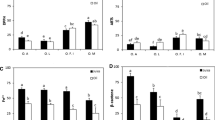Abstract
Bitter melon (Momordica charantia L.) is the traditional vegetable used as medicinal food in tropical and subtropical countries, including Korea, China, and India. The present work aimed to determine the content of carotenoids and fatty acid composition from pericarp and seed arils of ripened bitter melon fruits. Using HPLC–DAD, five major carotenoids in the pericarp and six carotenoids in seed arils of ripened bitter melon fruits were quantified. In pericarp, all-E-zeaxanthin was recorded in highest quantity (4.76 μg/g FW), followed by all-E-β-cryptoxanthin (2.68 μg/g FW) and all-E-violaxanthin (1.91 μg/g FW). All-E-lycopene was found as the most dominant carotenoid in red seed arils accounting for 273.15 μg/g (FW) with total carotenoid contents of 360.51 μg/g (FW). Using GC–FID, 11 fatty acids were identified in pericarp and seed arils. In pericarp, palmitic acid (C16:0) was found in highest quantity (29.53%) followed by linoleic acid (LA, C18:2, cis-9,12) (23.69%) and stearic acid (C18:0) (10.21%). In contrast, palmitic acid (39.28%), α-linolenic acid (ALA; C18:3, cis-9,12,15) (19.15%) and LA (15.28%) were the most dominant fatty acids in seed arils. The results of the present investigation revealed that the seed arils of ripened bitter melon fruits are rich sources of lycopene and PUFAs which can be used in food preparations as colorant and flavor enhancer to improve the health benefits, including lowering the risk of coronary heart disease, cancer, xerophthalmia and night blindness.




Similar content being viewed by others
References
T.C. Wehner, D.N. Maynard, in eLS (Wiley, New York, 2001)
K. Raina, D. Kumar, R. Agarwal, Semin. Cancer Biol. 40–41, 116 (2016)
S.P. Tan, T.C. Kha, S.E. Parks, P.D. Roach, Food Rev. Int. 32, 181 (2016).
R. Horax, N. Hettiarachchy, S. Islam. J. Food Sci. 70, C275 (2005)
S.D. Habicht, V. Kind, S. Rudloff, C. Borsch, A.S. Mueller, J. Pallauf, R. Yang, M.B. Krawinkel, Food Chem. 126, 172 (2011)
L.S. Ching, S. Mohamed, J. Agric. Food Chem. 49, 3101 (2001)
R.K. Saini, Y.-S. Keum, J. Food Meas. Charact. 11, 119 (2017)
P.A. Tuan, J.K. Kim, N.I. Park, S.Y. Lee, S.U. Park, Food Chem. 126, 1686 (2011)
R.K. Saini, S.H. Nile, S.W. Park, Food Res. Int. 76, 735 (2015)
L.H. Skibsted, J. Agric. Food Chem. 60, 2409 (2012)
C.B. Stephensen, in Carotenoids and Human Health, ed. by S.A. Tanumihardjo (Humana Press, Totowa, 2013), pp. 261–270.
B. Delplanque, Q. Du, G. Agnani, P. Le Ruyet, J. C. Martin, Prostaglandins Leukot. Essent. Fatty Acids PLEFA 88, 115 (2013).
A.H. Stark, M.A. Crawford, R. Reifen, Nutr. Rev. 66, 326 (2008)
D.B. Rodriguez, L.C. Raymundo, T.-C. Lee, K.L. Simpson, C.O. Chichester, Ann. Bot. 40, 615 (1976)
H.V. Chuyen, M.H. Nguyen, P.D. Roach, J.B. Golding, S.E. Parks, Int. J. Food Sci. Technol. 50, 567 (2015)
J. Kubola, N. Meeso, S. Siriamornpun, Food Res. Int. 50, 664 (2013)
L.T. Vuong, A.A. Franke, L.J. Custer, S.P. Murphy, J. Food Compos. Anal. 19, 664 (2006).
D.B. Rodriguez-Amaya, in A Guide to Carotenoid Analysis in Foods (ILSI Press, Washington, DC, 2001)
N.J. Miller, C.A. Rice-Evans, Free Radic. Res. 26, 195 (1997)
R.K. Toor, G.P. Savage, Food Res. Int. 38, 487 (2005)
E.G. Bligh, W.J. Dyer, Can. J. Biochem. Physiol. 37, 911 (1959).
R.K. Saini, N.P. Shetty, P. Giridhar, J. Am. Oil Chem. Soc. 91, 1029 (2014)
L.P. Jimenez Interiano, in Proximate Characterization and Lycopene Determination in Bitter Melon Seed Arils (University of Arkansas, Fayetteville, 2009)
S.H. Lee, Y.S. Jeong, J. Song, K.-A. Hwang, G.M. Noh, I.G. Hwang, Int. J. Food Prop. (2016). doi:10.1080/10942912.2016.1237961
USDA (2016). National nutrient database for standard reference, release 28. US Department of Agriculture, Agricultural Research Service. USDA Nutr. Data Lab. 9040 (2016)
I. Tlili, C. Hdider, M.S. Lenucci, I. Riadh, H. Jebari, G. Dalessandro, J. Food Compos. Anal. 24, 307 (2011)
J. Levy, M. Danilenko, M. Karas, H. Amir, A. Nahum, Y. Giat, Y. Sharoni, in Functional Foods for Disease Prevention I, ACS Symposium Series, vol 701, Chap 4 (American Chemical Society, 1998), pp. 34–41
A.V. Rao, S. Agarwal, Nutr. Res. 19, 305 (1999)
L.T. Vuong, J.C. King, Food Nutr. Bull. 24, 224 (2003)
L.T. Vuong, S.R. Dueker, S.P. Murphy, Am. J. Clin. Nutr. 75, 872 (2002)
G. Barceló-Coblijn, E.J. Murphy, Prog. Lipid Res. 48, 355 (2009)
R.A. Brown, in Omega-3 Fatty Acids (Springer, New York, 2016), pp. 413–428
J. Aranceta, C. Pérez-Rodrigo, Br. J. Nutr. 107, S8 (2012)
B.K. Ishida, C. Turner, M.H. Chapman, T.A. McKeon, J. Agric. Food Chem. 52, 274 (2004)
V. Böhm, R. Bitsch, Eur. J. Nutr. 38, 118 (1999)
M.A. Ali, M.A. Sayeed, M.S. Reza, M.S. Yeasmin, A.M. Khan et al., Czech J. Food Sci. 26, 275 (2008)
M.-K. Chang, E.J. Conkerton, D.C. Chapital, P.J. Wan, O.P. Vadhwa, J.M. Spiers, J. Am. Oil Chem. Soc. 73, 263 (1996)
Acknowledgements
This paper was supported by KU research professor program of Konkuk University, Seoul, Republic of Korea.
Author information
Authors and Affiliations
Corresponding authors
Ethics declarations
Conflict of interest
The authors have declared that there is no conflict of interest.
Rights and permissions
About this article
Cite this article
Saini, R.K., Assefa, A.D. & Keum, YS. Fatty acid and carotenoid composition of bitter melon (Momordica charantia L.) seed arils: a potentially valuable source of lycopene. Food Measure 11, 1266–1273 (2017). https://doi.org/10.1007/s11694-017-9504-7
Received:
Accepted:
Published:
Issue Date:
DOI: https://doi.org/10.1007/s11694-017-9504-7




